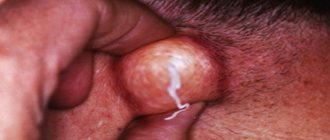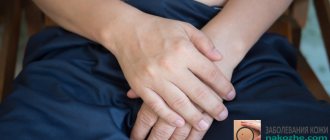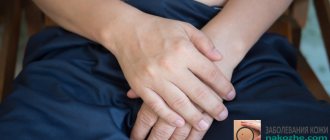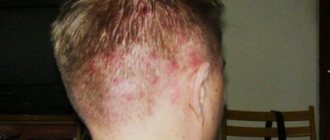A rash or rash is usually called any change in the skin or visible mucous membranes. The nature of rashes in men can be extremely varied. They can be represented by spots, blisters, blisters, nodules, peeling, erosions and even ulcers. Sometimes the same elements of the rash can be a manifestation of the disease, and in other cases a variant of the norm. The rash may be accompanied by various kinds of subjective sensations (itching, burning, pain). Rashes in the genital area in men are quite common. Among the main reasons that can lead to the appearance of rashes in the genital area in men, bacterial and viral infections, exacerbation of chronic dermatoses, the allergic nature of the rash and oncological processes should be noted. Rashes differ in volume, color, size, location, as well as in the nature of subjective sensations. Even an experienced doctor cannot always immediately make a diagnosis based on the nature of the rash. Often enough to establish the nature of the rash, i.e. Clinical diagnosis requires careful examination.
Particular attention should be paid if the rash: 1) exists for more than 1-2 weeks without changes; 2) accompanied by severe itching and swelling of the genital organs; 3) have the appearance of outlined reddish spots with slight peeling on the surface; 4) presented in the form of bubbles filled with clear, cloudy or bloody liquid; 5) appeared within several weeks after unprotected sexual intercourse; 6) accompanied by an increase in temperature or enlargement of the inguinal lymph nodes; 7) look like a completely painless ulcer; Fresh rashes form that do not go away on their own.
2) accompanied by severe itching and swelling of the genital organs; 3) have the appearance of outlined reddish spots with slight peeling on the surface; 4) presented in the form of bubbles filled with clear, cloudy or bloody liquid; 5) appeared within several weeks after unprotected sexual intercourse; 6) accompanied by an increase in temperature or enlargement of the inguinal lymph nodes; 7) look like a completely painless ulcer; Fresh rashes form that do not go away on their own.
Infectious acne
Dangerous rashes on the pubic area in women and men include those types of acne caused by pathogens. Treatment of such neoplasms is not only about eliminating symptoms. Initially, the nature of the infection is determined, and special samples and tests are taken in the laboratory. After which appropriate treatment is prescribed.
Pediculosis pubis
Pediculosis pubis is characterized by the appearance of parasites (pubic lice) in the groin area. These parasites can cause severe itching of the skin. When scratching areas of the skin, the layer of epidermis is destroyed, scratches and wounds appear, which can cause infection. You can become infected with this disease through sexual contact and at home. Lice can live in bedding and towels. Treatment for pubic lice is prescribed by a doctor.
Herpes
Symptoms appear as small pimples filled with translucent liquid. Pimples on the pubic area may burst, after which small wounds-ulcers are exposed on the surface. It is impossible to completely cure the herpes virus, but it is quite possible to relieve the symptoms and also get rid of unpleasant external rashes for a while.
Subcutaneous molluscum contagiosum
Outwardly, such a new growth on the skin is an unpleasant sight, however, infection with this disease does not bring anything good. External signs of this disease are pimples in the form of large blackheads. When you press on them, a white substance is released. You can become infected with molluscum contagiosum through an infected person. The appearance of molluscum contagiosum is not a good sign for the patient, since treatment of the disease is carried out along with surgery.
Causes
Rashes localized in the pubic area differ in appearance, size, shape, structure, etc. Taking into account the peculiarities of the visual manifestation of this symptom, the following list of diseases is determined that are characterized by the appearance of pimples on the pubis:
Pediculosis pubis. Infection with the causative agent of the disease - pubic lice, as a rule, occurs through sexual contact with a carrier of parasites, as well as common household items, personal hygiene, etc. The incubation period of the disease is one month. The first signs of its development are intense itching and burning in the groin area, irritation of the skin, and the formation of red pimples on the pubis at the sites of parasite bites. Due to constant scratching of the affected areas, patients with lice pubis are at risk of infection with pathogenic bacteria. In the complex treatment of the disease, local therapy with antiparasitic agents (ointments, shampoos, creams, etc.), special treatment of the patient’s bedding and underwear (thorough washing and ironing on both sides), as well as household items used by the patient (mattresses) are used. , upholstered furniture, etc.). Genital herpes. Against the background of infection with the herpes virus, which is highly contagious and sexually transmitted, a small pimple on the pubis may form, looking like a vesicle filled with greenish-yellow liquid exudate. One such formation quickly develops into multiple rashes, intense pain, burning and itching sensations appear. Patients also experience general weakness, malaise, nagging pain in the groin and lower back. After some time, the vesicular pimples burst, forming small, quickly healing ulcers. But since genital herpes is characterized by a constantly relapsing course, the rash soon appears again. Stress, hormonal imbalance, and hypothermia can trigger a relapse. Treatment of genital herpes, based on taking antiviral drugs, is symptomatic. This approach makes it possible to significantly reduce the intensity of the symptoms of the disease and increase the period of time between periods of its exacerbation. Molluscum contagiosum. Infectious pathology, the causative agent of which is a poxvirus, is usually manifested by the formation of pimples on the pubis, which look like dense pink papules with a shiny surface. If you press on such a pimple, there will be no pain, but a characteristic cheesy exudate will be released. Infection with molluscum contagiosum occurs at the moment of contact between healthy and virus-infected skin. Before the first symptoms of molluscum contagiosum appear, there is an incubation period (up to two months), during which the patient may not even be aware of the developing disease.
Given the high risk of virus transmission, it is necessary to pay timely attention to the treatment of pathology. To treat molluscum contagiosum, removal of the papular rash is used (laser correction method, cryotherapy, diathermocoagulation) followed by taking a complex of antiviral drugs and immunostimulants. Human papillomavirus
Pimples on the pubic area may look like small, hard lumps with a pointed tip and a smooth (in rare cases, bumpy) surface. Such formations indicate the pathogenic activity of papillomavirus in the human body. Infection with genital warts occurs during sexual contact with a carrier. Once it enters the body, the human papillomavirus remains there forever. To prevent frequent exacerbations of the disease and reduce the risk of developing malignant neoplasms, special complex treatment is necessary, including local therapy (local removal of rash elements), increasing the body’s resistance to the virus by taking antiviral, immunomodulating drugs, various interferons and stimulators of their production.
Purulent neoplasms
Ulcers occur when an ordinary pimple is accompanied by some kind of infection. In this case, the causative agent of the disease is determined and a course of antibiotics is prescribed.
Sakania Luiza Ruslanovna
Dermatovenerologist, cosmetologist, trichologist
Ask a Question
On the Internet you can find many photos depicting various types of formations on the skin. It is necessary to have at least an initial idea of what this or that disease looks like.
Rashes due to cancer processes
Rare, but extremely dangerous, are rashes as manifestations of oncological processes, including malignant neoplasms. Rashes can vary from macules, papules, to ulcerative elements. Queyra's syndrome is a precancerous disease characterized by the appearance of persistent edematous hyperemia of the glans penis. Subjective sensations are usually absent. Melanoma is an extremely dangerous disease that appears as spots of deep brown or black color. Squamous cell carcinoma manifests itself as painless erosions on the skin, prone to peripheral growth and fusion.
General signs of a possible oncological process: – long-term non-healing erosions or ulcers; – deformation of the genital organs; – appearance and rapid growth of pigment spots.
Why do acne appear?
Basically, their appearance on the pubic area in men and women occurs due to minor skin damage or due to improper hygiene. Shaving hair in the groin area may be accompanied by wounds or cuts. That's why pimples appear on the pubic area after shaving quite often. Lack of hygiene can also cause them to appear. The growth of pathogenic bacteria is affected by wearing synthetic underwear, because in this case the skin does not receive proper air flow.
Casual sex and contact with an infected person can cause an unpleasant rash and pimples on the pubic area. You should avoid intimate relationships with unfamiliar people, and it is best to have one, permanent partner. Personal hygiene is a personal choice for each person.
And finally, immunity. Decreased immunity can lead to the appearance of rashes and pimples in the groin area. A sharp decrease in human immune activity gives viruses an impetus for development. A healthy lifestyle and strengthening the immune system are another condition for good skin appearance.
Pimples on the pubic area - in women and men, causes, photos, purulent, red, why, big
Unlike acne on the face, acne on the pubic area is very often a sign of serious illness.
Therefore, not taking such rashes seriously can jeopardize not only your own health, but also put your loved ones at risk of infection.
Why do acne appear in the intimate area and what is the right thing to do if it is discovered?
- All information on the site is for informational purposes only and is NOT a guide to action!
- Only a DOCTOR can give you an ACCURATE DIAGNOSIS!
- We kindly ask you NOT to self-medicate, but to make an appointment with a specialist!
- Health to you and your loved ones!
Hair removal in the intimate area
More often, epilation of the pubic area is carried out by women, and therefore they also develop rashes associated with this more often.
The most common cause of acne after hair removal is the use of a razor.
Pimples that appear after shaving can be of two types:
- small red rashes scattered throughout almost the entire hair removal area - are formed due to a poor, dull razor, which injures the epidermis;
- single red or white pimples that cause discomfort - appear due to hair growing inward, first an area of inflammation is formed, and then bacteria are activated in it.
If any product was used to remove hair, the rash may be evidence of an allergic reaction to its composition.
In this case, the pimples will be small, located close to each other, but the entire area of the rash may be very itchy.
What to do if purulent acne appears on the pubic area
Regardless of whether men or women have purulent pimples on their pubic area, you cannot do without consulting a doctor.
purulent rashes in the intimate area
Only he can prescribe effective treatment, no matter how much you would like to solve the problem yourself.
Very often, the cause of ulcers is serious health problems or sexually transmitted diseases, therefore, by delaying a visit to the doctor, you thereby aggravate your disease and lengthen the period of struggle with it.
In men
- If a purulent pimple appears on a man’s pubis, the cause may be a simple lack of care or dirty laundry. Men work more physically and sweat. All these contaminants must be washed off daily with soap or a special product. But not all representatives of the stronger sex are advocates of hygiene, which is why blockage of pores often occurs. But if, despite all efforts to keep the intimate area clean, pustular rashes do not go away, you should consult a doctor.
- Another cause may be sexually transmitted diseases.
Purulent rashes that itch and cause discomfort and other unpleasant sensations require immediate consultation with a doctor.
Among women
In women, on the contrary, rashes in the pubic area can be caused by increased attention to this area, frequent hygiene procedures, shaving, and depilation. rashes can be caused by shaving the intimate area
rashes can be caused by shaving the intimate area
By the way, if there are purulent rashes, hair removal is contraindicated; this can provoke the spread of infection to healthy areas.
Hormonal causes and sexually transmitted diseases are also possible. Therefore, without a doctor and an accurate diagnosis, it makes no sense to take any measures.
Adviсe
Any disruptions in the body can cause rashes.
The skin always reacts sensitively to unfavorable changes, both external and internal.
Therefore, in order not to add to health problems, try to adhere to a healthy lifestyle.
Follow the principles of proper nutrition. Small errors from time to time will not cause harm to health, but why force the digestive organs to work at the limit of their capabilities all the time?
Choose your sexual partners carefully and use barrier methods of contraception. Sexually transmitted diseases are among the most difficult and long-term to cure.
Do not forget about daily hygiene procedures and changing linen.
Strengthen your immune system. Spend time outdoors every day, try to get enough sleep and be less nervous
These, at first glance, little things are important for the health of the whole body.
How to use the Darsonval device for acne? Find out here.
How to get rid of acne on a teenager's face? Read on.
Only a specialist can prescribe effective treatment.
Treatment with drugs
Drug treatment is always prescribed by a doctor. It is not worth doing this on your own, using any medications, as this will only worsen the situation. Each disease must be accompanied by treatment prescribed individually. Here, many signs of the patient’s general condition are taken into account: weight, age, pregnancy, tendency to allergies, etc.
The following drugs are mainly used to treat acne:
- Antibiotics.
- These can be either ointments containing the active substance or preparations for internal use.
- Antiseptics.
- Apply topically, treating the area of skin affected by infection.
- Antihistamines.
- Can be used in the form of ointments or tablets. Block the development of allergic reactions.
- Antiviral drugs.
- Used mainly to treat herpes and molluscum contagiosum.
- Insecticides.
- Special topical preparations (soap, shampoos, sprays).
It is worth remembering that it is not recommended to self-medicate before a diagnosis has been made and the nature of the origin of acne has been identified.
Possible diseases
Pimples on the pubic area may indicate the presence of sexually transmitted or skin diseases. In this case, additional symptoms may appear in the form of heavy discharge (sometimes mixed with blood or pus), itching and burning, pain during sex and/or urination. If you have these symptoms, you should consult a doctor who will make a diagnosis and prescribe appropriate treatment. Women can make an appointment with a gynecologist, and men with a dermatovenerologist.
Herpes virus
Genital herpes is a viral infection that is sexually transmitted. The main symptom of the disease is watery pimples filled with cloudy or clear liquid. After some time, the pimples burst and their contents flow out. The resulting ulcers must be regularly treated with antiseptics. If this is not done, the healing process will be delayed.
Once the herpes virus enters the body, it remains there forever.
Syphilis
Syphilis is a sexually transmitted infectious disease caused by Treponema pallidum.
You can become infected with syphilis through unprotected sexual intercourse, through contact with blood, mucous secretions and personal belongings of the patient. The first symptom of the disease is the formation of a chancre - a large pimple filled with liquid. Subsequently, small pink spots appear on the skin. These symptoms disappear on their own after a few weeks, which indicates further development of the disease. If left untreated, syphilis progresses and affects internal organs.
Pediculosis pubis
This parasitic disease is caused by pubic lice. You can get it through sexual intercourse, using other people's personal hygiene items, or being in public places (saunas, solariums, toilets, etc.).
A characteristic sign of lice is severe itching in the groin area and red spots that appear at the bite sites. The parasites themselves look like tiny black dots.
Molluscum contagiosum
Molluscum contagiosum is a viral infection that is transmitted through close contact with an infected person or his personal belongings. The disease is characterized by the appearance of watery blisters of a yellowish-pink color. Inside the papules there is a semi-liquid white content.
Scabies
This parasitic disease is accompanied by the appearance of vesicles connected by passages. You can diagnose scabies at home. To do this, apply iodine to the rash and observe the appearance of burrows (these areas turn brown when stained).
Seborrheic dermatitis
Yellow spots and plaques indicate the presence of seborrheic dermatitis. The disease can affect not only the groin area, but also other parts of the body. The areas most affected are those with many sebaceous glands: the chest, scalp, wings of the nose and cheekbones.
Treatment with folk remedies
The first assistant in the treatment of any type of acne is the aloe plant. The juice of this plant has truly healing powers. Purulent pubic acne is often treated with the juice of this plant. Before starting the manipulations, it is necessary to treat a freshly cut aloe leaf with boiling water, cut it lengthwise, and then apply it to the place where the pimple popped up. Apply a gauze bandage on top. Overnight, the boil will burst and the plant will draw out all the pus from the wound.
To eliminate the first symptoms of a rash, you can take healing baths with the addition of an infusion of medicinal herbs.
For treatment at home, regular iodine will be useful. If you treat the spots where acne appears with iodine, metabolic processes in the tissues will accelerate and the pus will come out faster.
Do not forget about hydrogen peroxide and ointments such as Levomekol, Vishnevsky ointment. These drugs are invariable assistants in the treatment of purulent infections. It is enough to apply the ointment several times to the internal pimple on the patient’s pubis and after a few days all the purulent mass will come out of the boil.
Symptoms of a boil
This disease has several stages of development, which are accompanied by such symptoms. redness appears on the pubic area or on the labia minora. You may notice swelling around the hair. Itching and discomfort appear.
severe pain occurs , because intimate places are highly sensitive than other parts of the body. The boil begins to thicken, a tubercle and swelling appear, and a pulsation is felt in the center.
The boil itself is a large pimple, it can reach 3 cm in diameter. Every day the amount of pus in it increases, and a rod matures in the middle. This disease may be accompanied by other symptoms : a rise in body temperature to 38 degrees, headache and muscle pain. If it occurs on the labia, the lymph nodes may also become inflamed, which can lead to serious consequences. Therefore, you should not delay treatment.
And at the third stage, the boil fully matures and breaks through . The tissues in the intimate places are freed from the accumulated pus and the rod that was there.
recovery begins , but you need to be very careful about hygiene in your intimate area. Despite the fact that the boil seems to be gone, the healing process is not over yet. Basically, the boil goes away in 8-12 days, but it can take longer, because this process depends on us.
But if the boil has not burst on its own after 5-7 days, then under no circumstances should you self-medicate , crush or puncture it, since microbes can enter the blood and cause serious complications; there have even been deaths. You need to urgently contact a surgeon; he will make a small incision and remove the pus. After these manipulations, the swelling will go away and the wound will heal, forming a scar.
Possible complications
The appearance of acne in the pubic area may be accompanied by the development of the following pathologies:
- Psoriasis.
- Chronic illness.
- Seborrheic dermatitis.
- The provoking factor for the development of dermatitis is disruption of the sebaceous glands.
- Bartholin gland cyst.
- The causative agents of the disease are pathogenic microbes.
- Inguinal athlete's foot.
- It appears in an environment favorable for the proliferation of harmful organisms and is characterized by the presence of spots that grow over the entire surface of the skin.
- Pemphigus.
- Watery pimples on the skin indicate the presence of this disease.
- Erythrasma.
- Occurs as a result of increased sweating. The disease is accompanied by itching and discomfort in the genital area.
- Impetigo.
- An infectious disease accompanied by the appearance of characteristic skin lesions. The causative agents are staphylococci and streptococci.
- Fungal skin lesions.
- They may appear in people with reduced immunity, as well as after long-term use of antibiotics. Fungal infections are dangerous due to their pathological processes and require immediate treatment.
Rashes due to bacterial and viral infections
Rash in the anogenital area in men can occur with a number of bacterial or viral infections, as well as with scabies or lice. The most common causes leading to the appearance of various rashes include syphilis, Reiter's syndrome, herpes simplex, human papillomavirus infection, candidiasis and other fungal pathogens, as well as molluscum contagiosum and scabies. Rashes can be similar for different reasons that led to their appearance, which significantly complicates diagnosis. Most often, rashes of an infectious nature manifest themselves as spots, nodules, blisters, erosions and ulcers. Depending on the type of rash, the nature of the disease can be assumed.
So, with syphilis, the nature of the rash can be very diverse. The rashes can be represented by small papules, erosions and even ulcers, depending on the stage of the disease. A distinctive feature of syphilis rashes is the absence of subjective sensations. With Reiter's syndrome (chronic chlamydia, the process is usually represented by flat nodules that can merge with each other, and can also be covered with mealy scales. Herpes simplex is usually characterized by typical rashes: grouped blisters with serous contents on a slightly edematous-hyperemic background. Anogenital warts: The main element of this contagious dermatosis is pointed papules.Sometimes they merge into large formations that resemble “cauliflower”.
With mitotic lesions of the skin and mucous membranes of the anogenital area, reddish spots of various sizes usually appear, which are accompanied by fairly intense itching. Molluscum contagiosum or viral dermatosis is manifested by flat or hemispherical nodules, inside of which there is a crumbly mass of whitish-yellowish color. Quite often, papules have an umbilical depression in the center. With parasitic dermatosis (scabies), the rash is caused by the activity of the scabies mite and has the appearance of characteristic burrows. The tick's entrance is represented by small dots, and as it moves, small bubbles appear in the skin. Nighttime itching is very typical.
Preventive measures
To prevent the development of complications dangerous to the health and life of the patient, preventive measures should be taken in a timely manner. Prevention should include several basic rules, for this it is necessary:
- pay special attention to personal hygiene;
- wear underwear made from natural fabrics; it should not be narrow or tight;
- avoid casual sexual contacts;
- adhere to proper nutrition;
- drink vitamins that can improve skin condition;
- avoid stressful situations and emotional stress;
- give up alcohol and smoking;
- seek medical help in a timely manner when the first signs of the disease are detected.
By following these simple rules of prevention, you can not only avoid the appearance of unpleasant acne on the body, but also improve your overall health.
You can ask your question to our author:
What to do if an abscess appears?
Having discovered any purulent neoplasm or painful lump in the groin area, it is better not to engage in self-diagnosis and self-medication. The best solution in such a situation is to seek medical help. A urologist, gynecologist or dermatologist can diagnose a boil and prescribe adequate treatment.
Under no circumstances should you heat the abscess or try to squeeze it out. Self-medication increases the risk of developing dangerous complications of boils.
Usually, to make a correct diagnosis, a doctor only needs to examine the patient and collect an anamnesis. Only in some situations may additional diagnostics be necessary. In particular, for recurrent follicles, a full examination and culture of the skin is carried out.
General recommendations for women and men
General recommendations for the treatment of boils are purely supportive and include:
- Taking vitamins. It is especially important to drink vitamin C, vitamins B1 and B2, as well as B12.
- Compliance with dietary nutrition. It is important to avoid eating various spices, smoked meats, fatty and spicy foods. Easily digestible, high-calorie foods containing many vitamins will be beneficial.
- Drinking enough regular clean water (to detoxify the body).
- Compliance with the work and rest regime. A good night's sleep is especially important.
- Wearing loose cotton underwear and fairly loose clothing. Tight trousers are prohibited.
- Eliminating prolonged pressure on problem areas, as well as preventing excessive sweating.
- Regular genital hygiene.
Compliance with general recommendations contributes to a successful recovery and helps to avoid complications.
Local treatment
If the boil is only at the infiltration stage - at the beginning of its formation - you can try to treat it with local medications. For this purpose you can use:
- Pulling ointments. Such remedies increase blood flow to the problem area, thereby activating blood circulation. The boil ripens easily and quickly enough, and then opens on its own. As a rule, pulling ointments should be applied under a bandage or under a patch to skin that has been pre-treated with antiseptics. To achieve the desired result, you can use Vishnevsky ointment and ichthyol ointment.
- Antibacterial ointments. Such medications destroy pathogenic microorganisms and can help eliminate the boil before it matures. Also, antibacterial medications can be used after spontaneous opening of the boil to destroy bacteria and prevent complications. The drugs of choice most often are Levomekol and Levosin. Tetracycline or erythromycin ointment, etc. can also be used. They should be applied to skin previously treated with antiseptics.
- Antiseptics. To wash a wound or treat the skin over a boil, it is most often recommended to use hydrogen peroxide, as well as a solution of chlorhexidine. The products are applied to the affected area in pure form, and excess is removed using a clean gauze swab. This procedure can be repeated several times a day until a hard crust forms on the surface of the wound or until the abscess spontaneously resolves.
- Healing agents. Such medications can be used only after complete suppression of bacterial inflammation. They promote rapid wound healing and also prevent the appearance of rough scars. Solcoseryl and Actovegin can achieve this effect. Sometimes doctors also recommend the use of Rescuer.
The use of local medications in the treatment of boils on the genitals is possible only after the approval of a doctor. The genitals are highly sensitive, so such treatment may require compliance with certain rules.
How to treat with antibiotics?
We have already talked about antibiotics in the context of topical treatments for boils. But when treating abscesses, such drugs can also be used systemically - in the form of tablets. Most often, systemic therapy is supplemented with local treatment - this way the pathogenic flora will be destroyed as quickly as possible.
When treating boils in the groin, drugs from the group can be used:
- Penicillin. Preference is given to medications with clavulanic acid - Augmentin, Amoxiclav, Flemoclav Solutab, etc.
- Cephalosporins. Of this group of drugs, cefixime is most often used.
- Macrolides. These are drugs with erythromycin, azithromycin, etc.
- Aminoglycosides. These medications are rarely the drugs of choice, but some doctors still prescribe them. Medicines in this group include neomycin, gentamicin, streptomycin, tobramycin, etc.
An experienced doctor can select the most suitable antibiotic in each specific case. In this case, the patient must scrupulously follow the recommended dosage, adhere to the correct dosage regimen, and also use the medicine for a strictly defined time period.
Surgery for abscesses on the genitals
Doctors try to avoid surgical treatment of boils on the genitals, trying to cope with the problem using conservative methods. However, if an abscess forms, surgical opening of the abscess may be necessary. The operation is performed under local anesthesia and includes:
- Abscess section.
- Elimination of pus.
- Using an antiseptic (and sometimes antibiotics) for rinsing.
- Installation of drainage.
- Applying a sterile dressing with antibacterial ointment.
Surgical treatment of boils is usually supplemented with oral antibiotics. Physiotherapeutic procedures may also be indicated for patients.
Is treatment possible with folk remedies?
Most doctors are quite skeptical about trying to self-medicate boils in the groin with folk remedies. Warming up the ulcers, applying lotions, baked onions and other substances to them can lead to the spread of the infectious and inflammatory process, as well as provoke more serious complications. Home treatment must necessarily be supplemented with drug therapy prescribed by a doctor. This may include taking medications that help strengthen the immune system, such as drugs with:
- Echinacea.
- Rosehip.
- Beekeeping products.
- Aloe etc.
Also, sometimes doctors allow the external use of antiseptic and anti-inflammatory traditional medicine. This effect is achieved by using:
- Decoction of oak bark. 2 tbsp. l. crushed raw materials, brew 200 ml of boiling water and cover with a lid. Soak this product in a water bath for 30 minutes, then strain, and squeeze out the remainder. Bring the finished medicine to the initial volume and use as directed.
- Infusion of chamomile flowers. 4 tbsp. l. raw materials, brew 200 ml of boiling water and leave in a thermos for 3 hours. Strain the finished product and squeeze out the rest. Use as directed.
Such medications should be used to treat the skin at the stage of abscess infiltration. Sometimes doctors allow short-term compresses with these agents.
It is worth considering that even such fairly safe medications can cause side effects and reactions of individual intolerance. They must be used with caution.









